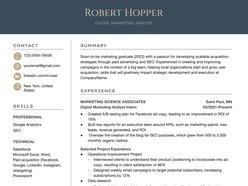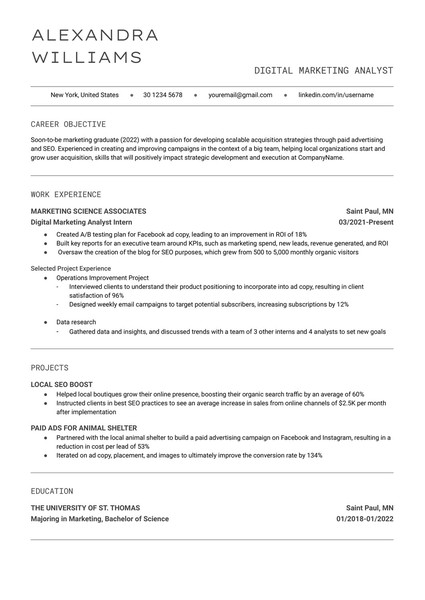How to Download and Use the Templates
Follow these steps to access and customize a Google Docs template efficiently:
- Browse Available Templates
Review the curated collection and identify a format that aligns with your event style and scheduling needs. - View Template Details
Select a template to open its dedicated detail page, where layout structure and key features are outlined. - Download the Template
Click the Download Template button to open the document directly in Google Docs. - Start Editing in Google Docs
In the opened document, select Use Template (top-right corner) to generate an editable copy. - Sign In to Google
Make sure you are signed into a Google account — this is required to save, personalize, and begin editing the template.
Once saved, the template becomes a fully customizable document — ready for editing, printing, or digital sharing with minimal setup.
How to Write a Student Resume in Google Docs Without Experience — And Still Get Noticed
When you're a student or recent graduate, building a resume with no formal job experience can feel daunting. But employers aren’t just hiring experience — they’re hiring potential. The key is showing what you’ve learned, how you’ve led, and where you’ve made an impact, even in academic or extracurricular settings.
This guide walks you through how to write a student resume in Google Docs — step by step — using a structure that emphasizes strengths, initiative, and real-world readiness.
1. Start With a Concise Summary That Highlights Your Goals and Strengths
Why it matters: A short, well-written summary introduces who you are and what direction you're aiming for — without sounding vague or overreaching.
Example:
“Motivated undergraduate in Environmental Science with strong research and data skills, seeking an internship focused on sustainability and climate analytics. Experienced in collaborative projects, presentations, and using tools like Excel and ArcGIS.”
In Google Docs, format this in a clean paragraph beneath your name and contact info — not as a heading.
2. List Education at the Top — But Add Value
Why it matters: For students, education is the core of your story — but it should include more than just the name of the school.
Good format:
B.S. in Computer Science
University of Oregon — Expected May 2026
Relevant Coursework: Data Structures, Python Programming, UX Design
GPA: 3.8 | Dean’s List (2023)
Only include GPA if it’s 3.5+. Listing coursework and honors gives context for your academic strengths.
3. Reframe School Projects and Class Assignments as Experience
Why it matters: If you don’t have a job history, your projects become your proof of initiative and skill.
How to write it:
Course Project — Mobile App Design (Spring 2024)
Designed a budgeting app prototype in Figma with a team of 3
Conducted user interviews and presented findings to class
Received highest peer review score among 12 teams
These are accomplishments — treat them like any other work experience. Bullet points. Outcomes. Action verbs.
4. Include Extracurricular Leadership, Even If It’s Informal
Why it matters: Employers care about teamwork, initiative, and communication. Student groups, clubs, and volunteer work all count.
Example:
Vice President — Debate Club
Organized weekly debates and trained new members
Led campus-wide event with 150+ attendees
Improved member participation by 40%
Use this section to show leadership, organization, and communication — key transferable skills.
5. Build a Skills Section That’s Clear and Specific
Why it matters: Avoid generic skill labels like “hard-working” or “good communicator.” List tools, methods, and platforms.
Best format in Google Docs (two-column bullet layout):
Tools: Google Docs, Excel, Canva, Figma
Technical: Python, HTML/CSS, Tableau
Soft Skills: Public speaking, teamwork, time management
Tailor this list to the job or internship you’re aiming for. Keep it tight and relevant.
6. Use Google Docs to Format Your Resume Clearly and Professionally
Why it matters: Your first resume shouldn’t be messy or inconsistent. Google Docs provides a clean structure and easy sharing.
Best practices:
Use bolded section headings (Education, Experience, Projects, etc.)
Keep fonts simple (Arial, Calibri, or Georgia)
Use consistent spacing and bullet styles
Export as PDF when applying — don’t send .docx
Templates designed for Google Docs already handle spacing and alignment, letting you focus on what really matters — your content.
Why Google Docs Works for Student Resumes
No design skills required — Focus on writing, not layout
Cloud-based — Easy to update from any device
Collaborative — Share with mentors or career advisors for feedback
Professional look — Clean PDF export for applications or LinkedIn upload
Final Note: Even Without Experience, You Have a Story
You don’t need a job title to show that you’ve contributed, solved problems, or built something valuable. A well-structured Google Docs resume can reflect your drive, your interests, and your readiness to learn — all of which are signals that matter more than just bullet points.
Start with your coursework. Add your projects. Mention what you’re proud of. Frame it clearly — and let that be your first step into the professional world.











